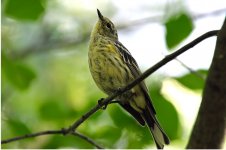Motmot said:
I´m glad to say I fully agree with Thayeri on these birds.

LOL! Have you noticed, Motmot, that we almost always do agree on the birds with photos this good? It is the more marginal photos that require a good bit of interpretation, that seem to lead to enjoyable discussions...

And speaking of discussions, hello JanJ! Yes, this bird does appear to have some conflicting characteristics from an aging perspective. As I indicated above, I don't like the thinness of the breast streaks for adult fall male -- but at the same time, the streaking right down the center of the breast is better for adult than first fall male (or adult female). So, I went with the extent of the gray in the upperparts (a first fall male should be browner, as an adult male would be when molting is complete), as well as the black lores and partially buffy throat to say 4-1 characteristics for adult over hatch year, most likely an adult. If the second photo is the same bird, as appears likely, I would still strongly tilt towards adult, because even though there is more brown visible -- it should be there and getting stronger for a molting adult, but not that amount of gray for a first fall male.
The wing coverts are an interesting area, thanks for pointing out the particulars! Yep, the thin streaks look better for first fall. However, while I didn't mention it above, I thought that the bold whiteness of the wing bars was another argument for adult, as a first fall male should have more of a brown wash to them, and be lower contrast. They do a look a bit browner in the second photo side view, but then again, that is supposed to be happen as an adult male goes to fall plumage.
Conflicting evidence, and as Dunn and Garrett say, not all fall adult males can be separated from first fall males, and fall adult females overlap with first fall males as well... fun with fall warblers!




